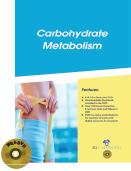Agriculture and Life Sciences

All living cells require energy to carry out various cellular activities. This energy is stored in the chemical bonds of organic molecules (e.g. carbohydrates, fats, proteins) that we eat as food. These organic molecules are broken down by enzymatic reactions in cells to generate energy in the form of adenosine triphosphate (ATP). The ATP generated by these pathways in cells is used to drive fundamental cellular processes. Carbohydrate metabolism denotes the various biochemical processes responsible for the formation, breakdown and interconversion of carbohydrates in living organisms. The most important carbohydrate is glucose, a simple sugar (monosaccharide) that is metabolized by nearly all known organisms. Glucose and other carbohydrates are part of a wide variety of metabolic pathways across species: plants synthesize carbohydrates from carbon dioxide and water by photosynthesis storing the absorbed energy internally, often in the form of starch or lipids. The breakdown of glucose to provide energy begins with glycolysis. To begin with, glucose enters the cytosol of the cell, or the uid inside the cell not including cellular organelles. Next, glucose is converted into two, three-carbon molecules of pyruvate through a series of ten di erent reactions. A speci c enzyme catalyzes each reaction along the way and a total of two ATP are generated per glucose molecule. Since ADP is converted to ATP during the breakdown of the substrate glucose, the process is known as substrate-level phosphorylation.